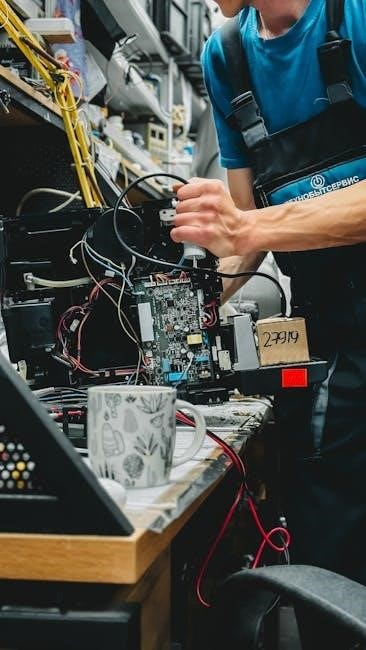
kenmore refrigerator troubleshooting manual
Discover essential tips and solutions for resolving common issues with your Kenmore refrigerator. This guide covers compressor malfunctions, ice buildup, and error codes, ensuring optimal appliance performance and longevity.
1.1 Overview of Common Issues
Kenmore refrigerators often face issues like compressor malfunctions, leading to cooling problems, and excessive ice buildup in the freezer. Users may also encounter error codes, unusual noises, or water leaks. These problems can stem from faulty sensors, clogged drains, or worn-out parts. Regular maintenance, such as cleaning condenser coils and checking door seals, can prevent many of these issues. Understanding these common problems is the first step toward effective troubleshooting and ensuring your appliance runs efficiently. This section provides a clear overview to help you identify and address these issues promptly.
1.2 Importance of Regular Maintenance
Regular maintenance is crucial for extending the lifespan of your Kenmore refrigerator and preventing costly repairs. Simple tasks like cleaning condenser coils, inspecting door seals, and checking drainage systems can significantly improve performance. Neglecting maintenance often leads to issues like compressor overheating or excessive ice buildup. By staying proactive, you can identify potential problems early, ensuring your appliance runs efficiently and reliably. A well-maintained refrigerator also reduces energy consumption and keeps your food fresh longer. Make maintenance a priority to avoid unexpected breakdowns and enjoy consistent cooling performance from your Kenmore appliance.
1.3 Safety Precautions Before Troubleshooting
Before attempting any repairs on your Kenmore refrigerator, ensure your safety by following essential precautions. Always disconnect the power supply to avoid electrical shocks or injuries. Wear protective gloves and eyewear when handling sharp or moving parts. Never attempt to repair damaged cords or plugs, as this can lead to serious hazards. Additionally, avoid bypassing safety features or tampering with electrical components. Always use proper tools and equipment to prevent further damage or accidents. If unsure about any step, consult the official manual or contact a professional technician for assistance.
Common Problems with Kenmore Refrigerators
Kenmore refrigerators often face issues like compressor malfunctions, excessive ice buildup, and error codes. These problems can disrupt performance, but the troubleshooting manual offers clear solutions and guidance.
2.1 Refrigerator Not Cooling Properly

If your Kenmore refrigerator isn’t cooling, it could indicate a compressor malfunction or issues with the condenser coils. A faulty compressor can prevent proper cooling, while blocked vents or dirty coils may restrict airflow. Check for ice buildup in the freezer, as this can also affect cooling performance. Ensure the door seals are tight to maintain internal temperature. Refer to the troubleshooting manual for diagnostic steps and potential solutions. Addressing these issues promptly can restore your refrigerator’s functionality and prevent food spoilage. Always consult the manual for model-specific guidance.
2.2 Excessive Ice Buildup in the Freezer
Excessive ice buildup in your Kenmore freezer can be caused by a faulty defrost system or a clogged drain. This issue may lead to reduced storage space and inefficient cooling. Check for blockages in the drain and ensure the defrost timer is functioning correctly. A malfunctioning compressor or damaged door seals can also contribute to excessive ice formation. Regular defrosting and cleaning can help prevent this problem. Refer to your troubleshooting manual for specific guidance on diagnosing and resolving ice buildup issues in your Kenmore model.
- Inspect the drain for blockages and clean if necessary.
- Ensure the defrost system is operating as intended.
- Check door seals for proper alignment and tightness.
2.3 Unusual Noises from the Refrigerator
Unusual noises from your Kenmore refrigerator, such as rattling, buzzing, or humming, can indicate issues with internal components. A malfunctioning compressor or a faulty evaporator fan may be the cause. Loose parts or improper installation can also lead to noise. Regular maintenance, such as tightening screws and ensuring proper alignment, can help resolve these issues. If the noise persists, consult the troubleshooting manual or contact a professional to avoid further damage. Addressing these noises promptly can prevent more severe problems and ensure smooth appliance operation.
- Check for loose components and tighten if necessary.
- Inspect the compressor and fan for proper function.
- Refer to the manual for specific diagnostic steps.
2.4 Water Leaks from the Refrigerator
Water leaks in your Kenmore refrigerator can be caused by a clogged defrost drain, faulty water valve, or issues with the ice maker. Regularly inspect the drain line for blockages and ensure it’s clear. If the leak persists, check the water supply line for damage or loose connections. Refer to the troubleshooting manual for specific guidance on diagnosing and repairing these issues. Addressing leaks promptly can prevent water damage and maintain your refrigerator’s efficiency. Always turn off the water supply before attempting any repairs.
- Inspect the defrost drain for blockages.
- Check the water supply line for damage or leaks.
- Consult the manual for detailed repair steps.
2.5 Refrigerator Not Turning On
If your Kenmore refrigerator isn’t turning on, start by checking the power supply. Ensure the outlet is working and the circuit breaker hasn’t tripped. Verify that the power cord is securely plugged in. Next, inspect the temperature control settings to ensure they’re not set too high. Faulty door switches or sensors might also prevent the fridge from operating. Consult the troubleshooting manual for guidance on diagnosing electrical issues. If the problem persists, it may indicate a faulty compressor or control board, requiring professional assistance. Always prioritize safety when handling electrical components.
- Check the power supply and circuit breaker.
- Verify temperature control settings.
- Inspect door switches and sensors.

Official Kenmore Refrigerator Troubleshooting Manual
The official manual provides comprehensive guidance, including safety precautions, parts identification, and step-by-step troubleshooting instructions. Access it online for detailed repair solutions and maintenance tips.
3.1 How to Use the Manual Effectively
To maximize the benefits of the Kenmore refrigerator troubleshooting manual, start by locating your appliance’s model number for precise guidance. Review the safety precautions thoroughly before attempting any repairs. Identify the specific issue using the detailed troubleshooting section, which often includes error codes and symptoms. Refer to the parts identification section to understand component locations and functions. Follow the step-by-step repair instructions carefully, ensuring you use genuine Kenmore parts for reliability. For complex issues, consult additional resources or contact a professional if needed.
3.2 Key Components of the Troubleshooting Guide
The Kenmore refrigerator troubleshooting guide includes essential sections like safety precautions, parts identification, and step-by-step repair instructions. It provides detailed diagrams and error code explanations to diagnose issues accurately. The guide also covers disassembly procedures for accessing internal components safely. By referencing your appliance’s model number, you can find tailored solutions. Always use genuine Kenmore parts for repairs to ensure compatibility and reliability. This comprehensive resource helps users address common problems efficiently, reducing the need for professional assistance in many cases.
3.3 Accessing the Official Kenmore Appliance Manuals Online
To access the official Kenmore appliance manuals, visit the Microsoft Download Center or the Kenmore website. Enter your model number in the search bar to find specific guides. These manuals include safety precautions, parts identification, and troubleshooting steps. They also provide detailed diagrams and repair instructions. For convenience, you can access these resources alongside other Microsoft services like Word and Excel online. Ensure to use genuine Kenmore parts for repairs, as specified in the manual, to maintain appliance performance and safety.

Error Codes and Their Meanings
Understanding error codes is crucial for diagnosing issues in your Kenmore refrigerator. These codes help identify specific problems, guiding you through the troubleshooting process effectively.
4.1 Common Error Codes in Kenmore Refrigerators
Kenmore refrigerators display specific error codes to indicate malfunctions. Codes like E1 and SY EF signal issues with sensors, while PF may indicate power failure. Understanding these codes helps in identifying the root cause, whether it’s a faulty compressor, temperature sensor, or communication error. Referencing the official troubleshooting manual is essential for accurate diagnosis and repair. These codes guide users to resolve problems efficiently, ensuring the appliance operates smoothly and maintains optimal performance.
4.2 How to Reset Error Codes
To reset error codes on your Kenmore refrigerator, start by unplugging the appliance from the power source. Wait for 30 seconds to allow the system to reset. Plug it back in and check if the error code disappears. If the issue persists, ensure all doors are sealed properly and sensors are functioning. For specific codes, consult the official troubleshooting manual for guidance. Resetting error codes can often resolve minor glitches, but recurring issues may require professional assistance to address underlying problems;
4.3 Troubleshooting Error Codes Step-by-Step
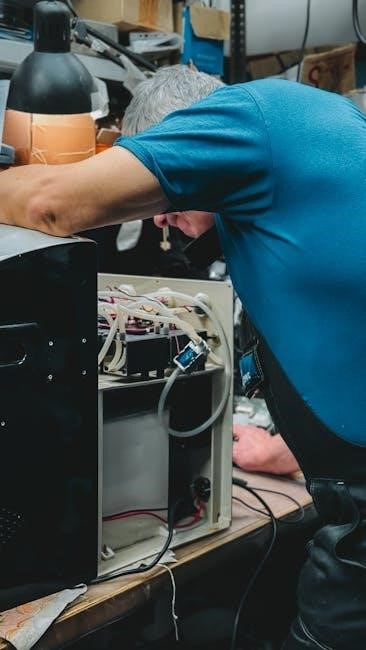
Identify the error code displayed on your Kenmore refrigerator’s control panel. Refer to the official troubleshooting manual to understand its meaning. Perform a power reset by unplugging the appliance for 30 seconds. Check sensors, doors, and ice makers for malfunctions. If the code persists, inspect components like the compressor or temperature sensors. Clean or replace faulty parts as needed. For complex issues, consult the manual’s diagnostic charts or contact a professional. Systematic troubleshooting ensures accurate repairs and prevents further damage to your appliance.
DIY Repair and Fix Solutions
Empower yourself with DIY solutions for common Kenmore refrigerator issues. Clean condenser coils, check door seals, and replace water filters. Defrosting and simple part replacements can often resolve problems quickly.
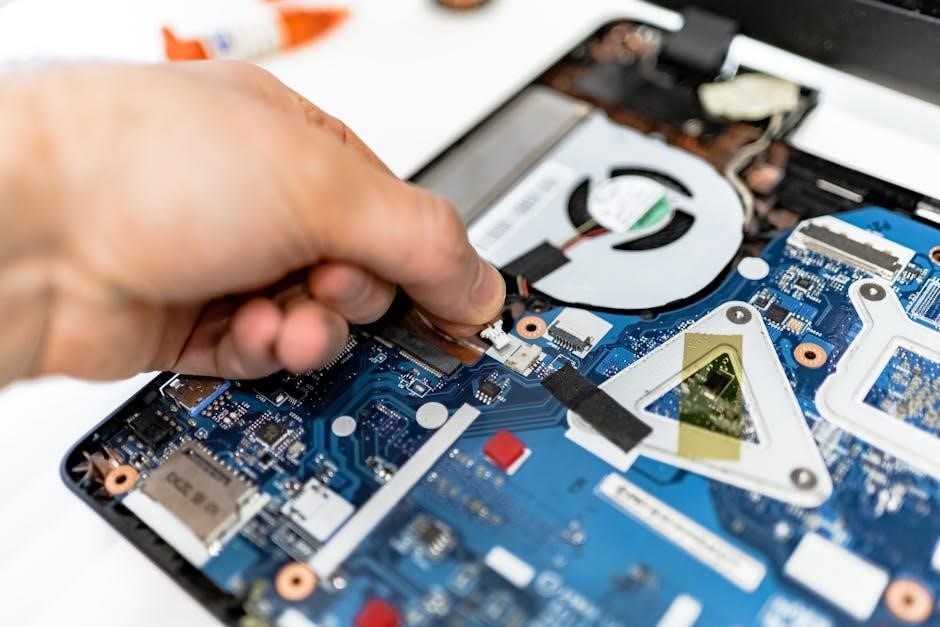
5.1 Simple Fixes for Common Refrigerator Issues
Address common Kenmore refrigerator problems with easy DIY solutions. If your fridge isn’t cooling, check the condenser coils for dust and clean them. For excessive ice buildup, ensure the freezer drain isn’t clogged. If error codes appear, refer to the manual for reset instructions. Regularly inspect door seals to prevent air leaks. Defrosting the appliance and replacing water filters can also resolve many issues. These simple fixes can save time and money before calling a professional. Always unplug the fridge before attempting repairs to ensure safety.
5.2 Replacing Faulty Parts at Home

Identify and replace faulty parts in your Kenmore refrigerator with ease. Common issues like a malfunctioning compressor or faulty water filters can often be resolved by replacing the defective components. Use the official manual to locate the correct parts and follow disassembly instructions. Ensure to purchase genuine Kenmore replacement parts for reliability. Basic tools like screwdrivers and wrenches are usually sufficient for most replacements. Always unplug the fridge before starting repairs to avoid electrical hazards. Replacing parts at home can save costs, but if unsure, consult a professional for complex fixes.
5.3 Defrosting and Cleaning the Refrigerator
Regular defrosting and cleaning are crucial for maintaining your Kenmore refrigerator’s efficiency. Excessive ice buildup can impair performance, so defrosting every 3-6 months is recommended. Turn off the fridge, remove contents, and let ice melt naturally or use a towel to speed up the process. Clean the interior with mild soap and warm water, paying attention to shelves and drawers. Check and clean drain hoses to ensure proper water flow. Refer to the official manual for specific defrosting instructions tailored to your model. A clean fridge prevents odors and ensures optimal cooling, while also reducing energy consumption.
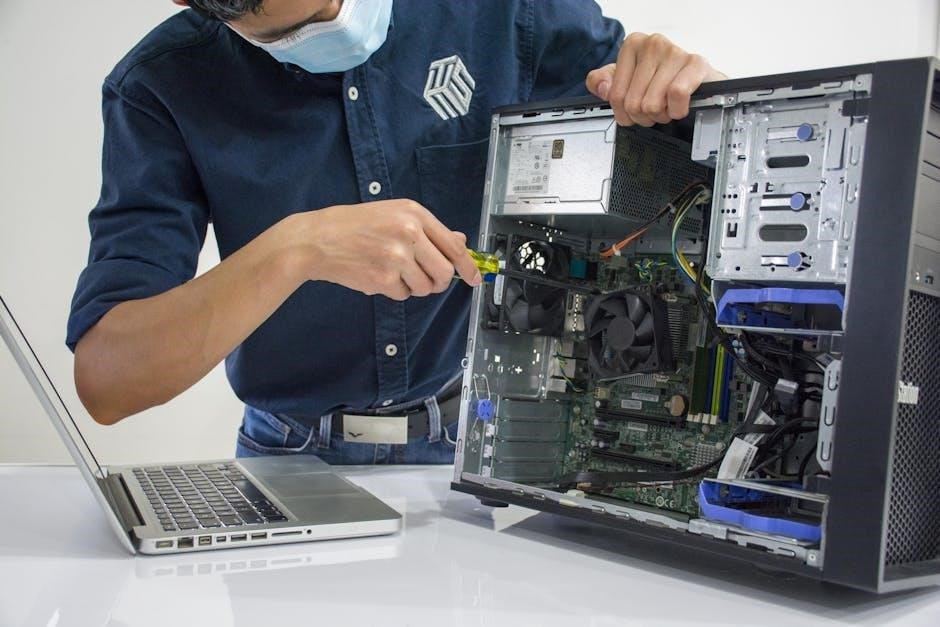
When to Call a Professional
Consult a professional if issues like compressor failure or complex error codes arise, as these require specialized tools and expertise to resolve effectively and safely.
6.1 Signs That You Need Expert Assistance
If your Kenmore refrigerator displays persistent error codes, has a malfunctioning compressor, or shows signs of extensive ice buildup, it’s crucial to seek professional help. These issues often require specialized tools and expertise to diagnose and repair effectively. Ignoring these signs can lead to further damage or safety hazards. A professional can ensure the problem is resolved safely and efficiently, preventing future breakdowns and maintaining your appliance’s performance. Don’t hesitate to contact a certified technician if you’re unsure about handling these complex repairs yourself.
6.2 Complex Repairs Beyond DIY Capabilities
Certain repairs, such as compressor replacements or electrical system overhauls, are beyond the scope of DIY fixes. These tasks require advanced technical knowledge and specialized tools to ensure safety and effectiveness. Improper handling of these components can lead to further damage or even safety hazards. Always consult a professional for such complex issues to guarantee a reliable and long-lasting solution. Their expertise will help restore your Kenmore refrigerator to optimal performance without risking additional problems or personal safety.
Maintenance Tips to Prevent Future Issues
Regularly clean condenser coils, inspect door seals, and replace water filters to prevent malfunctions. These simple steps ensure efficient operation and extend your refrigerator’s lifespan.
7.1 Regular Cleaning and Inspection
Regular cleaning and inspection are vital for maintaining your Kenmore refrigerator’s performance. Clean the condenser coils every 6 months to ensure proper airflow and energy efficiency. Inspect door seals for cracks or wear, as damaged seals can lead to cooling issues. Check the drain hose for blockages and ensure it’s clear to prevent water leaks. Additionally, defrost the freezer regularly to avoid excessive ice buildup. These simple maintenance tasks can prevent common problems and extend the lifespan of your appliance. Regular inspections help identify potential issues early, ensuring your refrigerator runs smoothly and reliably.
7.2 Checking and Replacing Filters
Regularly checking and replacing filters in your Kenmore refrigerator is essential for maintaining water quality and airflow. The water filter should be replaced every 6 to 12 months to prevent bad taste, odor, or reduced ice production. Clean or replace the air filter every 3 to 6 months to ensure proper humidity control and odor management. Refer to your manual for specific instructions on locating and replacing these filters. Always use genuine Kenmore replacement parts to ensure compatibility and performance. Proper filter maintenance helps prevent issues like water leaks or cooling inefficiencies, keeping your refrigerator running smoothly and effectively. Regular checks can also extend the lifespan of your appliance.
7.3 Ensuring Proper Door Seals and Alignment
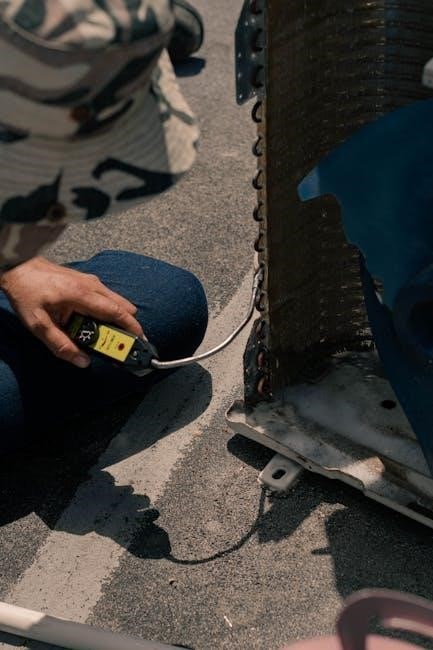
Proper door seals and alignment are crucial for maintaining your Kenmore refrigerator’s efficiency and performance. Inspect the door seals regularly for cracks or wear, as damaged seals can lead to air leaks and temperature fluctuations. Misaligned doors may cause uneven cooling or increased energy consumption. To fix alignment issues, adjust the hinges or replace worn-out parts. Clean the seals with mild soap and water to ensure a tight seal. Regular checks can prevent moisture buildup, frost accumulation, and energy waste. Refer to your manual for specific adjustment instructions and always use genuine Kenmore replacement parts for optimal results. Proper door alignment ensures consistent cooling and extends appliance lifespan. Regular maintenance helps avoid costly repairs and keeps your refrigerator running efficiently. By addressing seal and alignment issues promptly, you can maintain optimal performance and prevent future problems. This simple step is vital for preserving your refrigerator’s functionality and energy efficiency. Always prioritize door seal integrity to ensure your Kenmore refrigerator operates at its best. Proper door alignment also prevents noise and vibration, ensuring smooth operation. Regular inspections and adjustments are key to maintaining your appliance’s overall health and performance. This proactive approach saves time and money in the long run. Proper door seals and alignment are essential for maintaining your Kenmore refrigerator’s efficiency and performance. Inspect the door seals regularly for cracks or wear, as damaged seals can lead to air leaks and temperature fluctuations. Misaligned doors may cause uneven cooling or increased energy consumption. To fix alignment issues, adjust the hinges or replace worn-out parts. Clean the seals with mild soap and water to ensure a tight seal. Regular checks can prevent moisture buildup, frost accumulation, and energy waste. Refer to your manual for specific adjustment instructions and always use genuine Kenmore replacement parts for optimal results. Proper door alignment ensures consistent cooling and extends appliance lifespan. Regular maintenance helps avoid costly repairs and keeps your refrigerator running efficiently. By addressing seal and alignment issues promptly, you can maintain optimal performance and prevent future problems. This simple step is vital for preserving your refrigerator’s functionality and energy efficiency. Always prioritize door seal integrity to ensure your Kenmore refrigerator operates at its best. Proper door alignment also prevents noise and vibration, ensuring smooth operation. Regular inspections and adjustments are key to maintaining your appliance’s overall health and performance. This proactive approach saves time and money in the long run. Proper door seals and alignment are essential for maintaining your Kenmore refrigerator’s efficiency and performance. Inspect the door seals regularly for cracks or wear, as damaged seals can lead to air leaks and temperature fluctuations. Misaligned doors may cause uneven cooling or increased energy consumption. To fix alignment issues, adjust the hinges or replace worn-out parts. Clean the seals with mild soap and water to ensure a tight seal. Regular checks can prevent moisture buildup, frost accumulation, and energy waste. Refer to your manual for specific adjustment instructions and always use genuine Kenmore replacement parts for optimal results. Proper door alignment ensures consistent cooling and extends appliance lifespan. Regular maintenance helps avoid costly repairs and keeps your refrigerator running efficiently. By addressing seal and alignment issues promptly, you can maintain optimal performance and prevent future problems. This simple step is vital for preserving your refrigerator’s functionality and energy efficiency. Always prioritize door seal integrity to ensure your Kenmore refrigerator operates at its best. Proper door alignment also prevents noise and vibration, ensuring smooth operation. Regular inspections and adjustments are key to maintaining your appliance’s overall health and performance. This proactive approach saves time and money in the long run. Proper door seals and alignment are essential for maintaining your Kenmore refrigerator’s efficiency and performance. Inspect the door seals regularly for cracks or wear, as damaged seals can lead to air leaks and temperature fluctuations. Misaligned doors may cause uneven cooling or increased energy consumption. To fix alignment issues, adjust the hinges or replace worn-out parts. Clean the seals with mild soap and water to ensure a tight seal. Regular checks can prevent moisture buildup, frost accumulation, and energy waste. Refer to your manual for specific adjustment instructions and always use genuine Kenmore replacement parts for optimal results. Proper door alignment ensures consistent cooling and extends appliance lifespan. Regular maintenance helps avoid costly repairs and keeps your refrigerator running efficiently. By addressing seal and alignment issues promptly, you can maintain optimal performance and prevent future problems. This simple step is vital for preserving your refrigerator’s functionality and energy efficiency. Always prioritize door seal integrity to ensure your Kenmore refrigerator operates at its best. Proper door alignment also prevents noise and vibration, ensuring smooth operation. Regular inspections and adjustments are key to maintaining your appliance’s overall health and performance. This proactive approach saves time and money in the long run. Proper door seals and alignment are essential for maintaining your Kenmore refrigerator’s efficiency and performance. Inspect the door seals regularly for cracks or wear, as damaged seals can lead to air leaks and temperature fluctuations. Misaligned doors may cause uneven cooling or increased energy consumption. To fix alignment issues, adjust the hinges or replace worn-out parts. Clean the seals with mild soap and water to ensure a tight seal. Regular checks can prevent moisture buildup, frost accumulation, and energy waste. Refer to your manual for specific adjustment instructions and always use genuine Kenmore replacement parts for optimal results. Proper door alignment ensures consistent cooling and extends appliance lifespan. Regular maintenance helps avoid costly repairs and keeps your refrigerator running efficiently. By addressing seal and alignment issues promptly, you can maintain optimal performance and prevent future problems. This simple step is vital for preserving your refrigerator’s functionality and energy efficiency. Always prioritize door seal integrity to ensure your Kenmore refrigerator operates at its best. Proper door alignment also prevents noise and vibration, ensuring smooth operation. Regular inspections and adjustments are key to maintaining your appliance’s overall health and performance. This proactive approach saves time and money in the long run. Proper door seals and alignment are essential for maintaining your Kenmore refrigerator’s efficiency and performance. Inspect the door seals regularly for cracks or wear, as damaged seals can lead to air leaks and temperature fluctuations. Misaligned doors may cause uneven cooling or increased energy consumption. To fix alignment issues, adjust the hinges or replace worn-out parts. Clean the seals with mild soap and water to ensure a tight seal. Regular checks can prevent moisture buildup, frost accumulation, and energy waste. Refer to your manual for specific adjustment instructions and always use genuine Kenmore replacement parts for optimal results. Proper door alignment ensures consistent cooling and extends appliance lifespan. Regular maintenance helps avoid costly repairs and keeps your refrigerator running efficiently. By addressing seal and alignment issues promptly, you can maintain optimal performance and prevent future problems. This simple step is vital for preserving your refrigerator’s functionality and energy efficiency. Always prioritize door seal integrity to ensure your Kenmore refrigerator operates at its best. Proper door alignment also prevents noise and vibration, ensuring smooth operation. Regular inspections and adjustments are key to maintaining your appliance’s overall health and performance. This proactive approach saves time and money in the long run. Proper door seals and alignment are essential for maintaining your Kenmore refrigerator’s efficiency and performance. Inspect the door seals regularly for cracks or wear, as damaged seals can lead to air leaks and temperature fluctuations. Misaligned doors may cause uneven cooling or increased energy consumption. To fix alignment issues, adjust the hinges or replace worn-out parts. Clean the seals with mild soap and water to ensure a tight seal. Regular checks can prevent moisture buildup, frost accumulation, and energy waste. Refer to your manual for specific adjustment instructions and always use genuine Kenmore replacement parts for optimal results. Proper door alignment ensures consistent cooling and extends appliance lifespan. Regular maintenance helps avoid costly repairs and keeps your refrigerator running efficiently. By addressing seal and alignment issues promptly, you can maintain optimal performance and prevent future problems. This simple step is vital for preserving your refrigerator’s functionality and energy efficiency. Always prioritize door seal integrity to ensure your Kenmore refrigerator operates at its best. Proper door alignment also prevents noise and vibration, ensuring smooth operation. Regular inspections and adjustments are key to maintaining your appliance’s overall health and performance. This proactive approach saves time and money in the long run. Proper door seals and alignment are essential for maintaining your Kenmore refrigerator’s efficiency and performance. Inspect the door seals regularly for cracks or wear, as damaged seals can lead to air leaks and temperature fluctuations. Misaligned doors may cause uneven cooling or increased energy consumption. To fix alignment issues, adjust the hinges or replace worn-out parts. Clean the seals with mild soap and water to ensure a tight seal. Regular checks can prevent moisture buildup
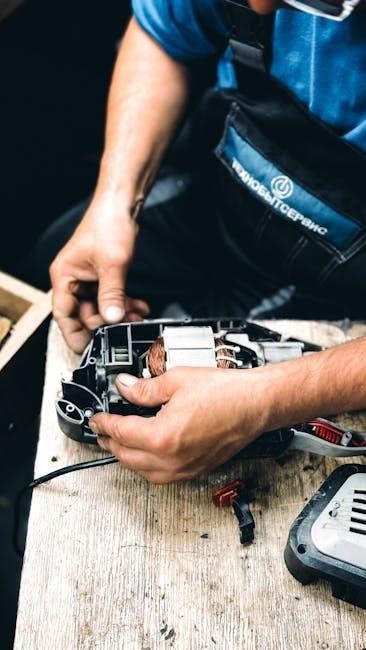
Model-Specific Troubleshooting
Model-specific troubleshooting addresses unique issues for different Kenmore refrigerator models, ensuring effective repairs and optimal performance. Refer to your manual or online resources for tailored solutions.
